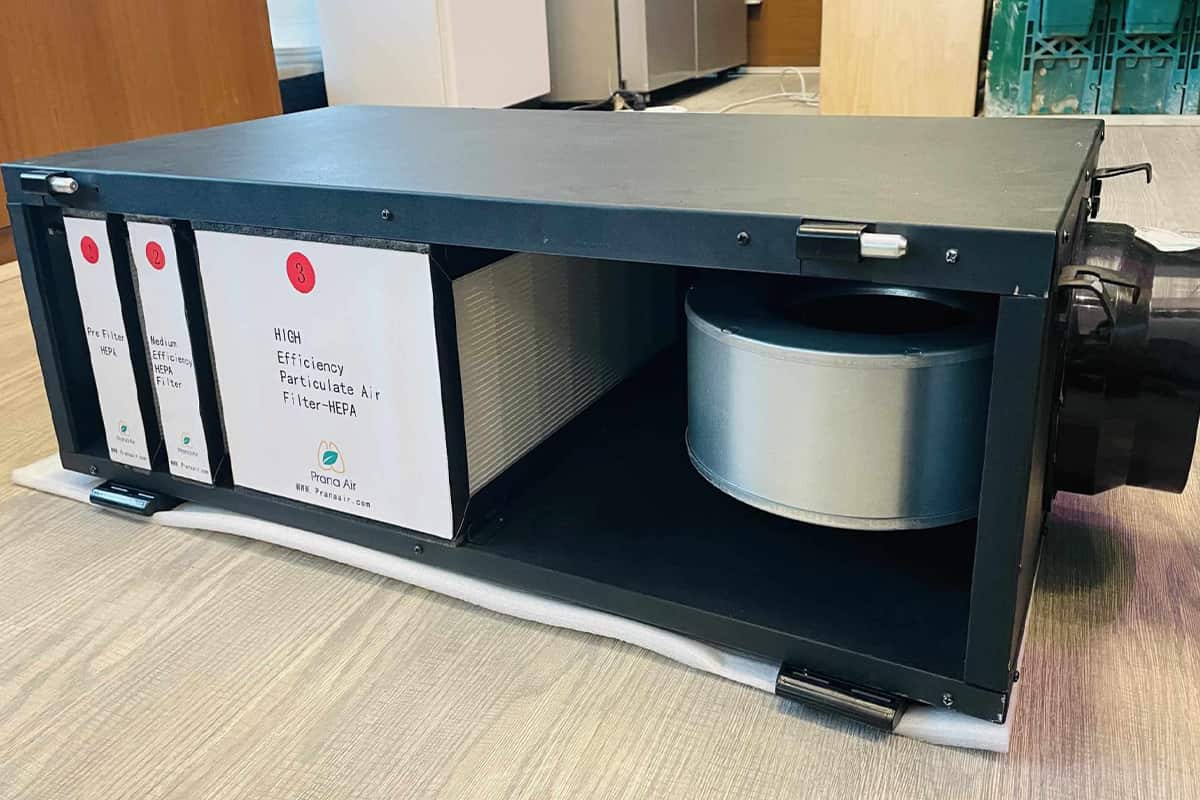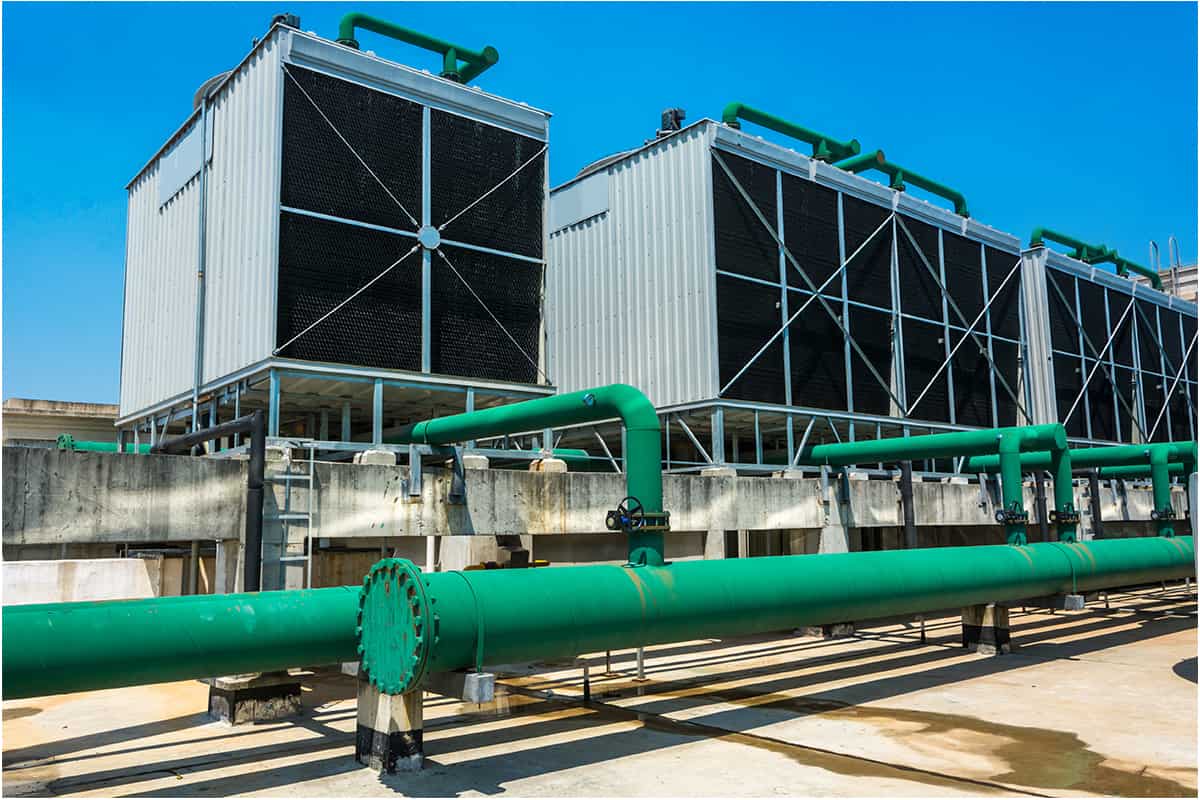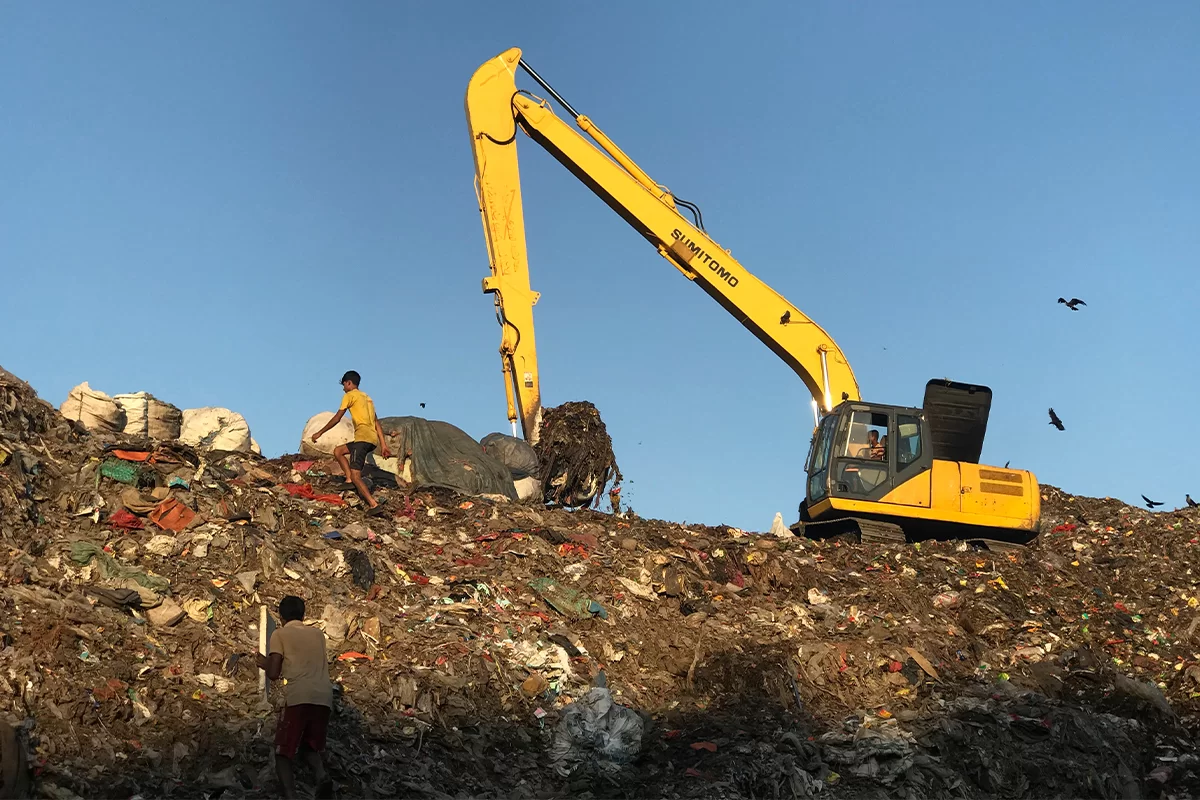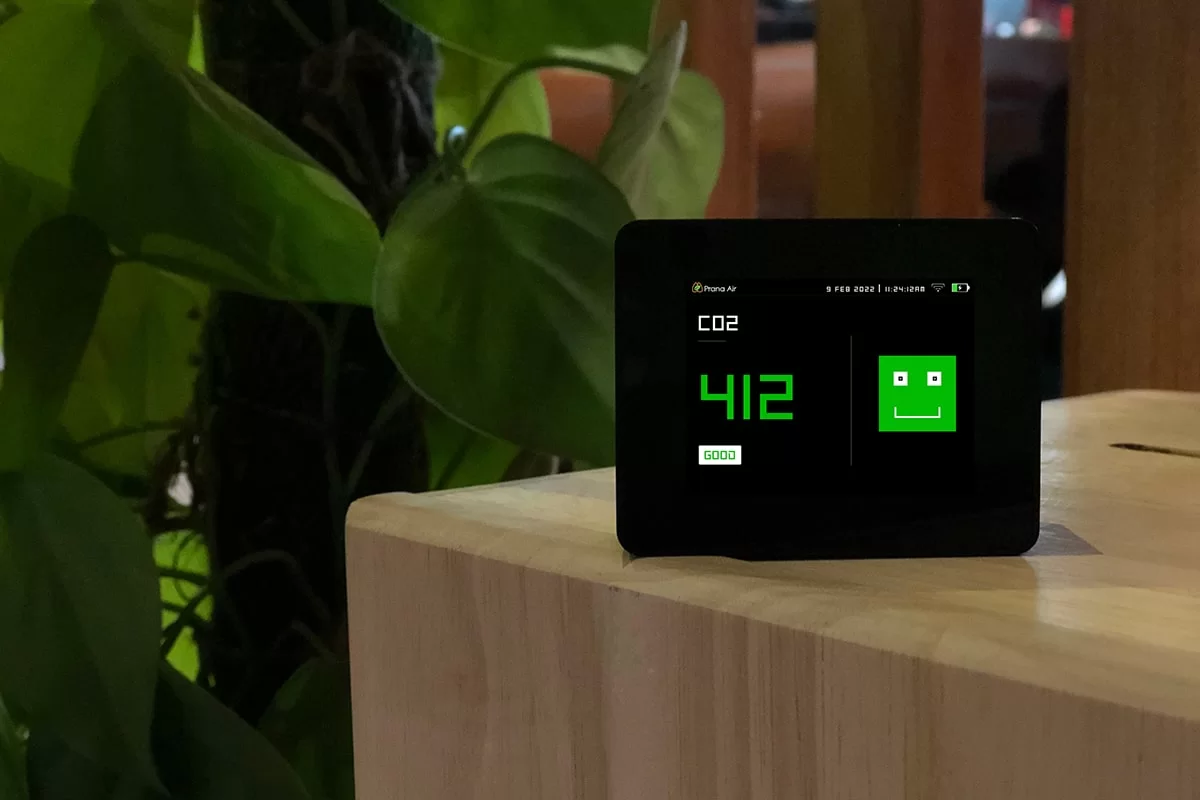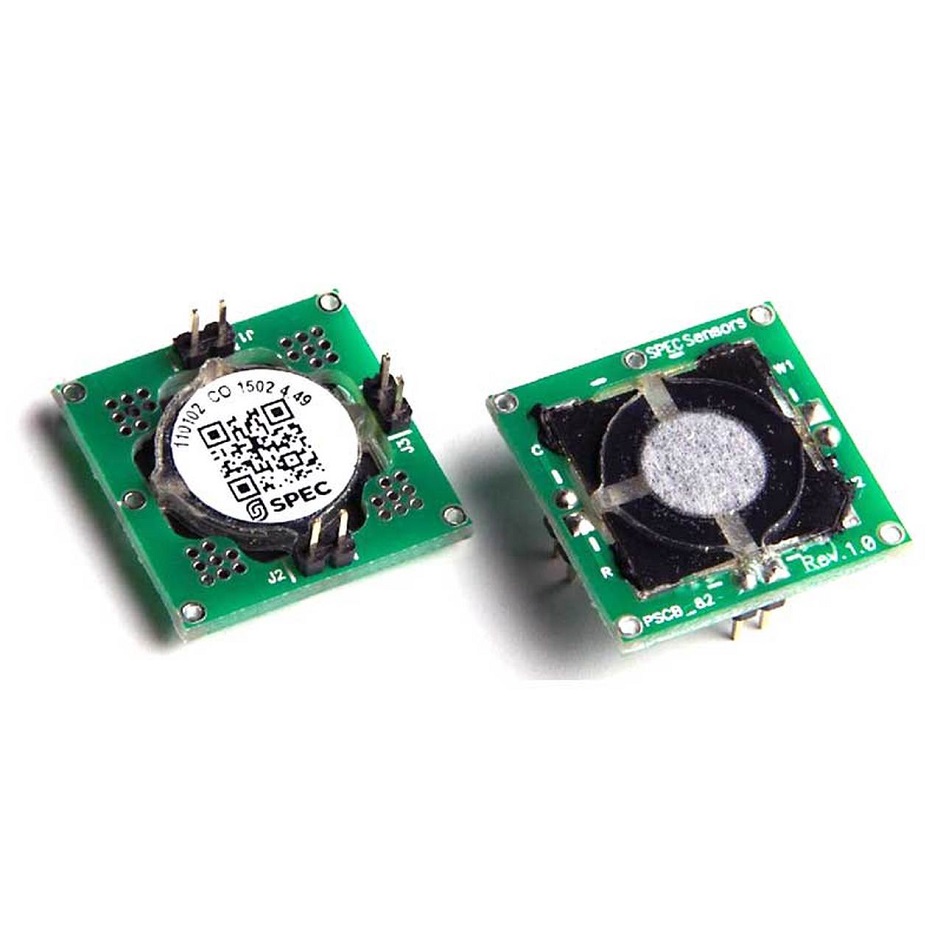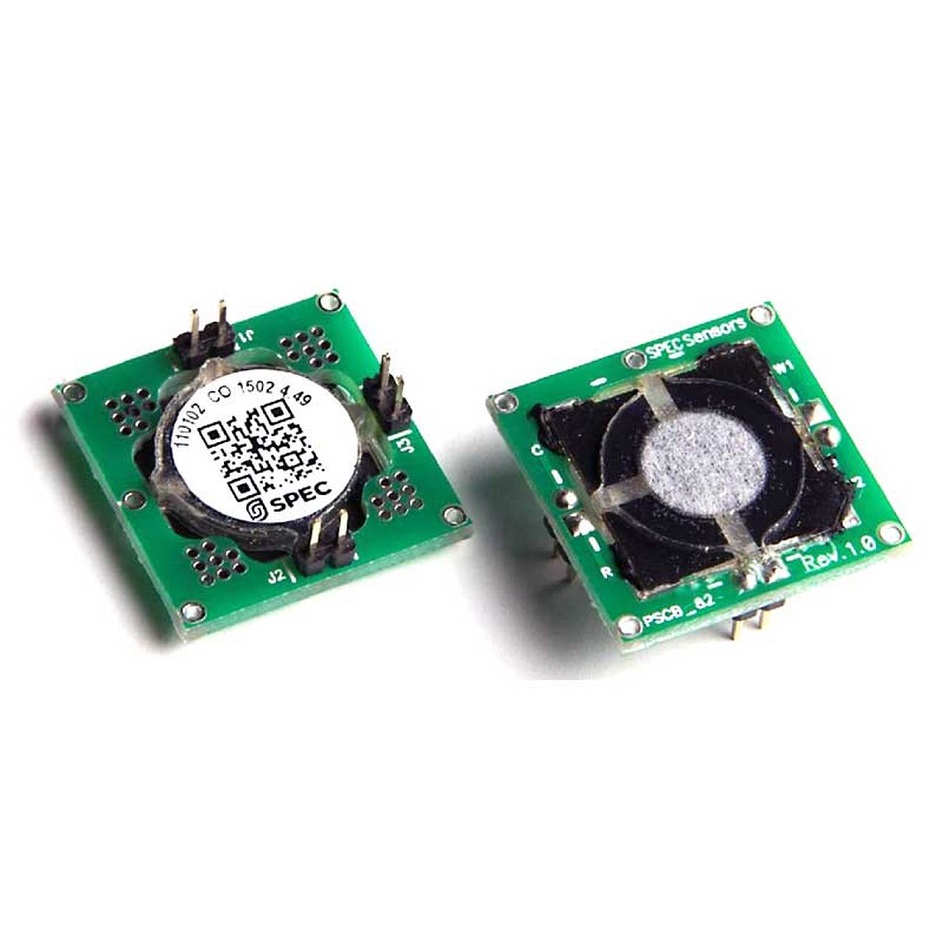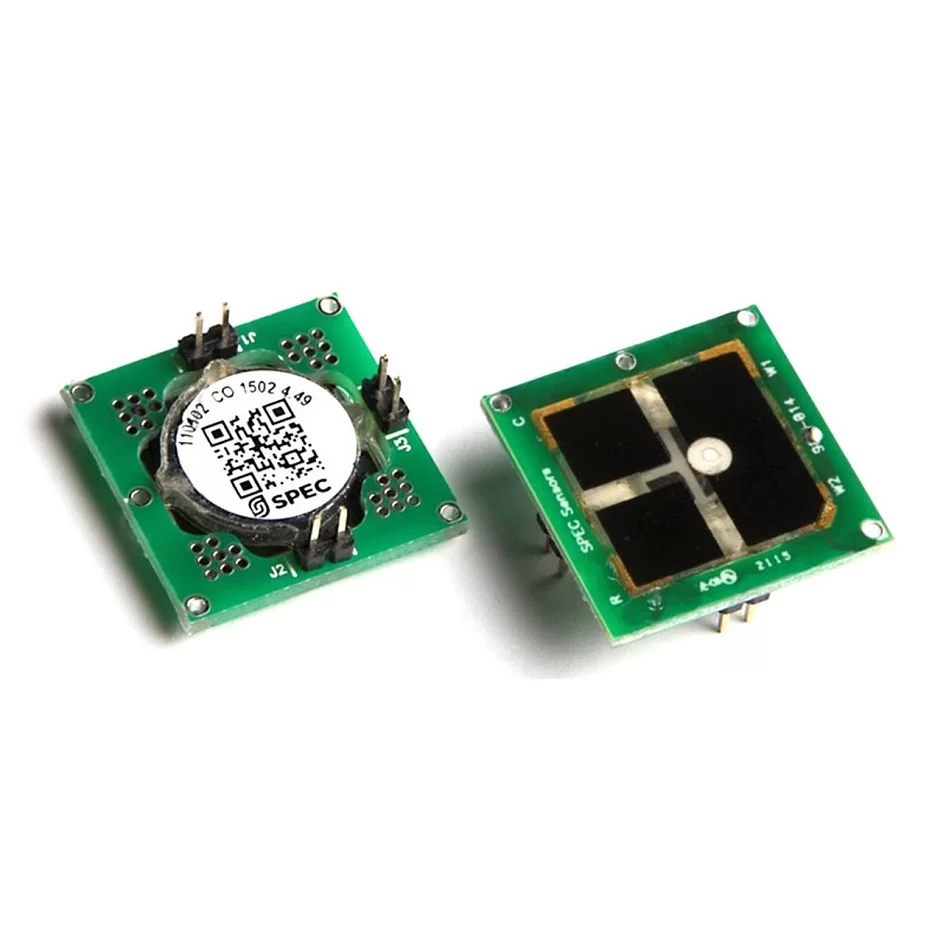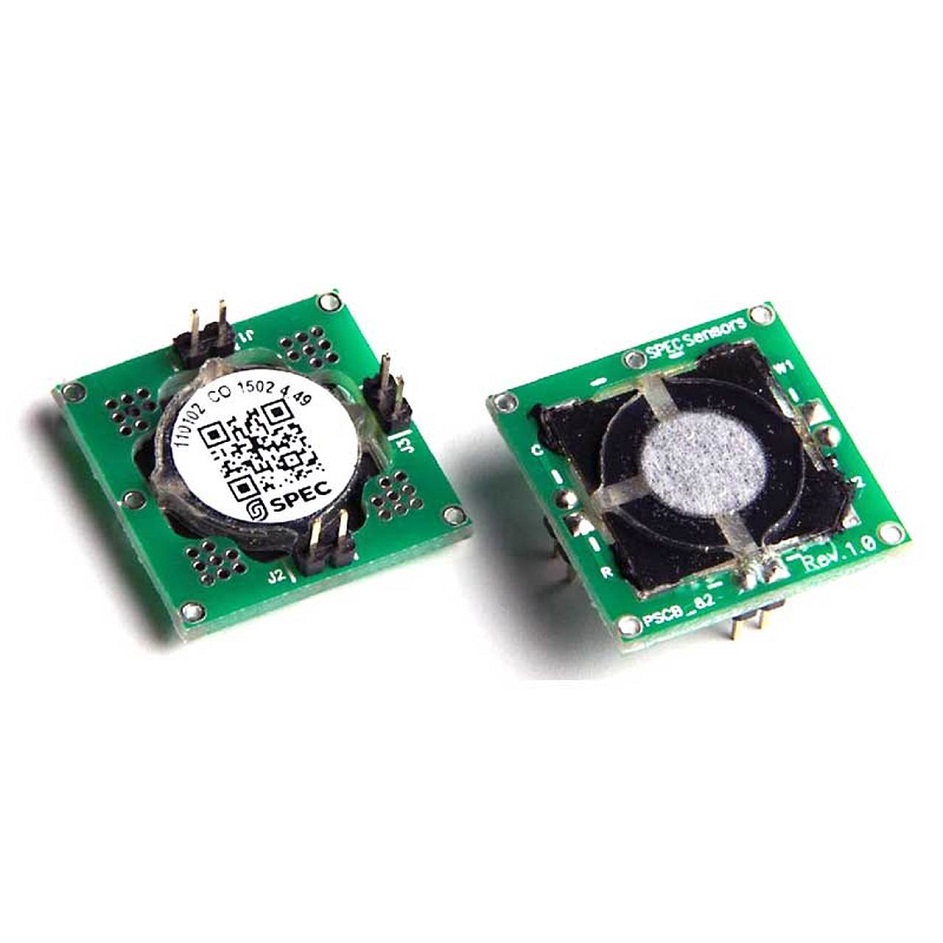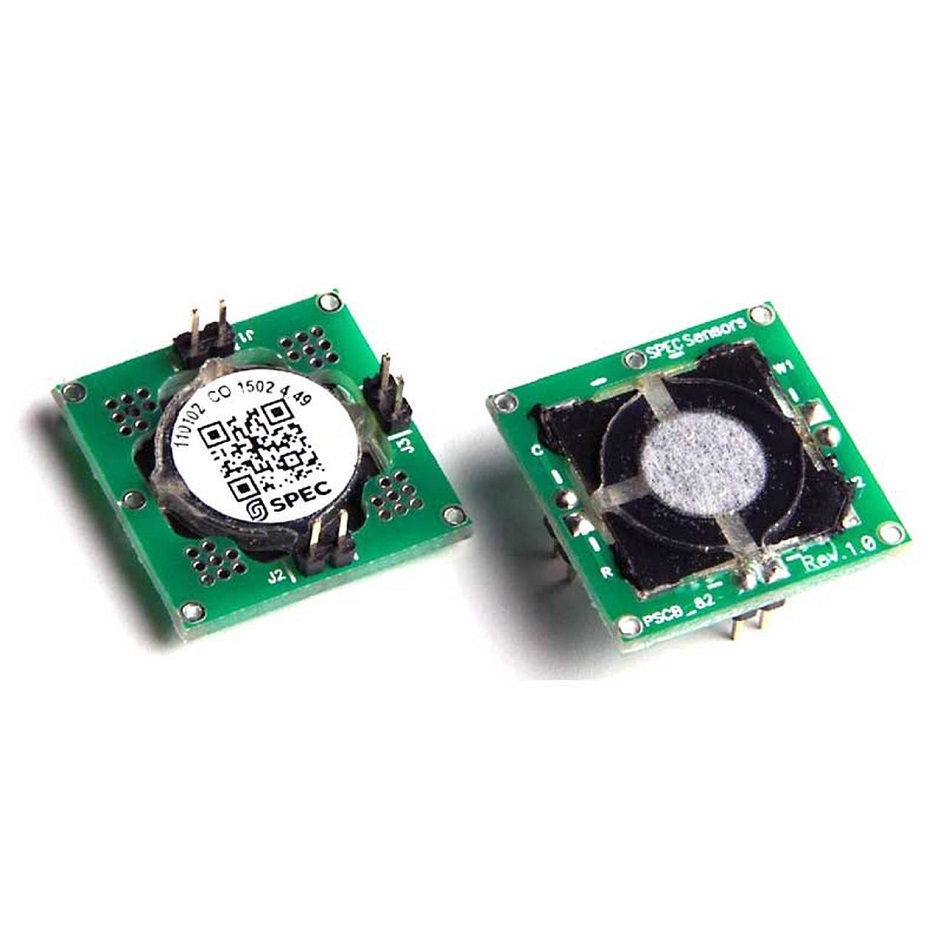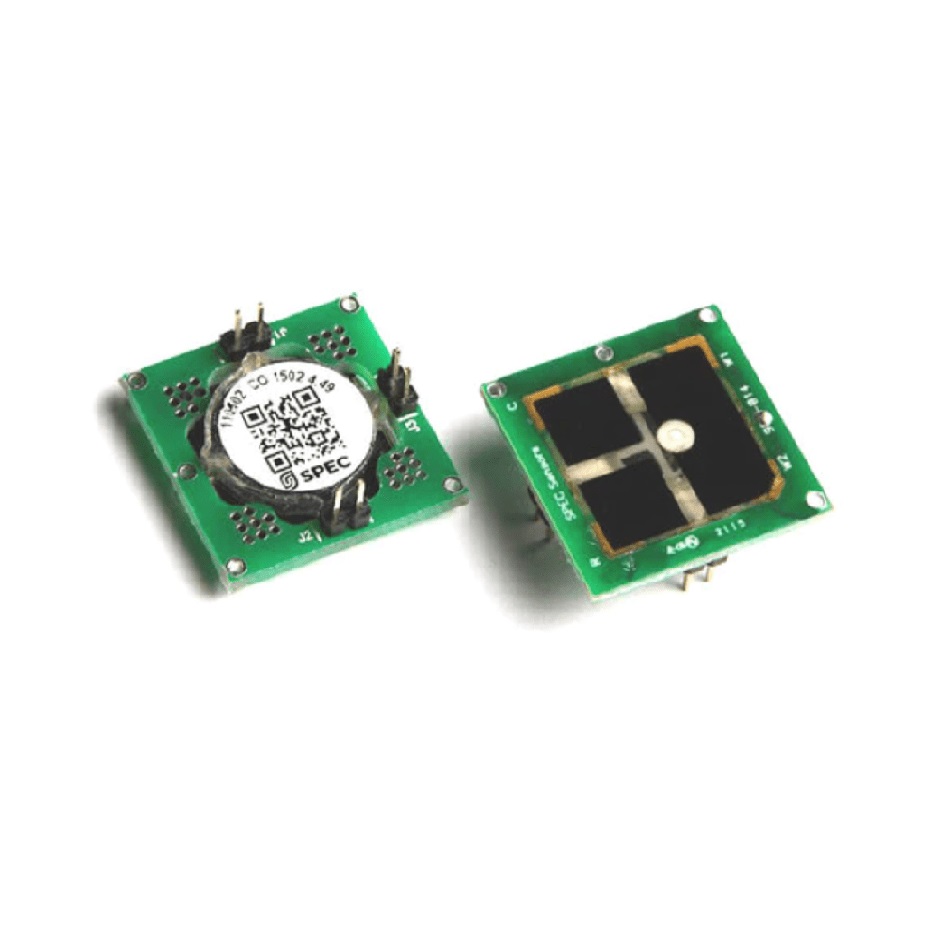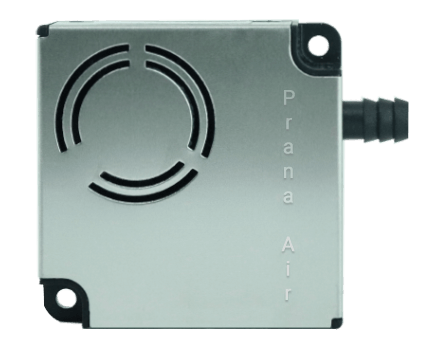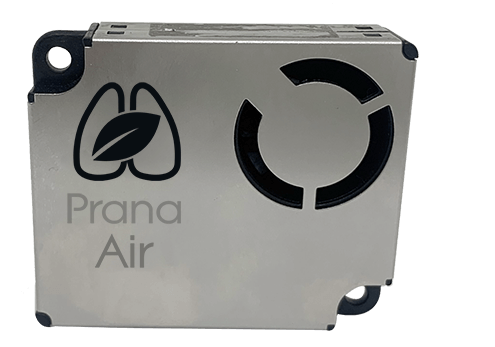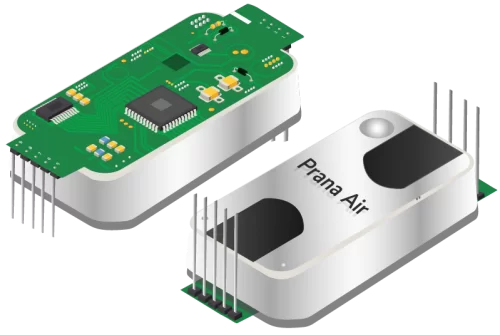
CO2 Sensor NDIR
Prana Air CO2 sensor is a non-dispersive infrared NDIR sensor with 1 PPM resolution and a 10,000 PPM range. It is very accurate and responsive. This type of sensor is the most sought-after sensor over other detection technologies by accuracy, long-time stability and low-power consumption for measuring CO2. Our sensor provides accurate and reliable observations which can be used not only at the consumer level but for experimental and research purposes.
NDIR co2 sensor consists of an IR emitter, detector, optical filter, gas cell, and signal processing circuit parts. Furthermore, these components provide options for selection, such as a light-emitting diode (LED), and an infrared (IR) lamp, all of which may generate IR spectra.
What are the unique features
of Prana Air CO2 Sensor?

Fast Response
Our co2 sensor is apt for real-time air monitoring due to low response time. They are quick and accurate.

High Accuracy
It is apt for real-time air monitoring due to accurate results and quick response time.

Reliable & Durable
The sensor is highly accurate and also durable with a capacity to work up to 10 years.

Manual Calibration
Method for manual operation: Join the sensor’s Zero pin to the low level (0V).
![]()
Auto-Calibration
It has an auto-calibration mechanism with fresh air, and no need for maintenance.

Signal output PWM/UART
Connect module’s Vin-GND-RXD-TXD to user’s 5V-GND-TXD-RXD

Compact Size
The sensor is compact enough to fit into any monitor for indoor and outdoor monitoring purposes.

Customer Support
Customer support is available for the requirement of customization.
Technology We Use
Nondispersive Infrared (NDIR) CO2 Sensor 
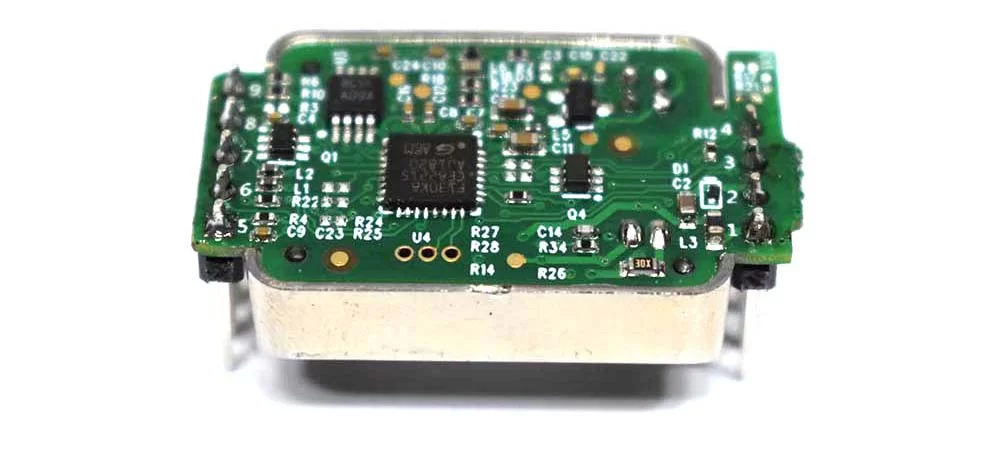
How does Prana Air’s CO2 sensor work and calculate Its concentration?
Our carbon dioxide (CO2) sensors are based on NDIR technology, which stands for Non- Dispersive Infrared radiation. This procedure is commonly used to detect carbon-based gases in the atmosphere, such as CO2. The CO2 gas enters the sensor, and light from the Infrared (IF) source falls on the CO2 molecules. These molecules absorb some light at a 4.26 µm wavelength. This absorption is directly proportional to carbon dioxide molecules and it gives the concentration of carbon dioxide. The sensor calculates the concentration on the basis of the absorption of light by gas molecules.
Why is it necessary to monitor carbon dioxide gas?
Carbon dioxide is a gas exhaled by human beings as a part of their respiration process. As the population grows and the number of individuals per square foot rises, CO2 concentrations can be substantially higher indoors than they are outside. The usual CO2 level in outdoor air is 400 parts per million or ppm, and it is now growing at a rate of 2 ppm every year. Indoors, due to stuffy rooms or insufficient ventilation, this level can reach up to 2000 ppm. Drowsiness, exhaustion, impaired thinking and decision-making skills, poor concentration, dizziness, migraines, and an elevated heart rate are all possible side effects. Coma, suffocation, and convulsions are some of the long-term effects. That is why it is essential to monitor CO2 concentrations indoors.
A study from the Cooperative Institute for Research in Environmental Sciences and the University of Colorado Boulder showed that monitoring carbon dioxide levels indoors can help in identifying the transmission risk of viral infections such as coronavirus. Researchers from MIT showed a relationship between pathogen concentration and exposure time. Other than this, to reduce the major health impacts of carbon dioxide such as Sick Building Syndrome reduced productivity, nausea, dizziness, absenteeism, etc.
Dimension
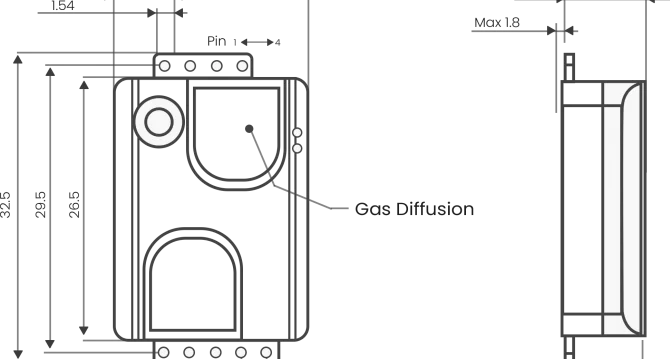
Sensor Calibration
Prana Air sensors are calibrated by the zero-point calibration method. This method reveals a range of measurements of the instrument. The zero point for sensor calibration is 400 ppm and the calibration cycle is of 96 hours (4 days) duration.

CO2 Air Quality Index Score
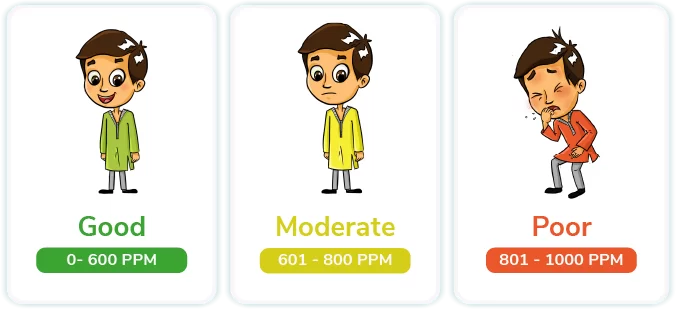
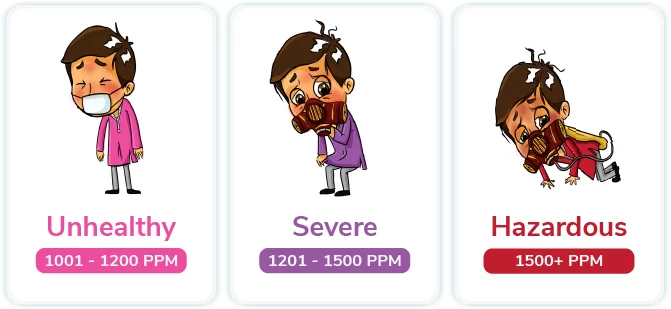
Carbon dioxide is colorless, water soluble, inflammable, non-toxic gas. The gas has acidic odor and is naturally occurring in nature. Its is 53% more than of dry air. The gas can be found both indoor and outdoor environment. The key indicator of indoor air quality is carbon dioxide. The concentration of gas is increasing consistently in nature. The increase in its concentration is seen due to activities of human like deforestation, fossil fuel burning, fuel combustion, reaction between water and carbonate rock produces the gas, volcanic eruptions and the process of respiration in which carbon dioxide is exhaled from the human body in environment.
A scientific study among working individual showed that at 945 ppm level 15% of workers were not able to make decision effectively whereas at 1400 ppm 50% of workers were not able to make decision effectively along with a control group of workers at 550 ppm exposure of CO2.



Technical Indicators of CO2 Sensor
| Parameter | Value |
|---|---|
| 1. Measurement Range | 0 to 10,000 ppm |
| 2. Type of Sensor | NDIR |
| 3. Resolution | 1 ppm (instrumentation dependent) |
| 4. Accuracy | ± 50 ppm ± 5% of reading |
| 5. Response time | 15s (90%) |
| 6. Working temperature | 0℃~50℃ |
| 7. Working humidity | 0~95%RH(non-condensing) |
| 8. Storage temperature | -40℃~70℃ |
| 9. Storage humidity | 0~95%RH(non-condensing) |
| 10. Power supply | DC 5.0V+5%; ripple wave<50mV |
| 11. Working current | Average≤20mA@1s |
| 12. Signal output | UART_TTL, PWM |
Uses of Prana Air CO2 Sensor 
Carbon dioxide levels can be substantially higher indoors than they are outside. As a result, CO2 levels
must be monitored indoors, particularly in poorly ventilated or enclosed spaces.

Offices
Due to the compact settings of offices, ventilation of air seems almost impossible. Increased CO2 levels in the workplace can make employees tired, lethargic, and ineffective. Delays in submissions and work deadlines are possible after effect.

Airports
According to a National Library of Medicine study, air travel poses a danger of transmission both on the plane and within the airport. Except in a highly packed boarding area with 300 people present, carbon dioxide levels within the airport stayed below 800 ppm.

Automobiles
In confined spaces such as cars, CO2 monitoring becomes particularly important. Increased levels of CO2 inside a car can be life-threatening. When CO2 levels in a car grow, the driver may experience drowsiness and is prone to falling asleep, making accidents more likely.

Hospitals
In a hospital, CO2 monitoring is an easy, inexpensive, and often ignored means of monitoring the condition of the patient. An Infinium Medical, Inc. study published in 2011 discovered that a type of carbon dioxide monitoring could have avoided 82 percent of intensive care accidents that resulted in a cerebral fatality.

Classrooms
Carbon dioxide CO2 sensors in classrooms, according to the University of Melbourne, have a number of benefits, the most notable of which is improved air quality monitoring. This improvement in air quality has a positive impact on the health of students. In healthier, ventilated environments, grades and attendance improve.

Hotels
As many hotels have poorly ventilated rooms, CO2 levels exceed the recommended limit. You can experience suffocation, stuffiness, and nausea due to this. It is important to monitor CO2 levels inside hotels to avoid symptoms like headaches, drowsiness, etc.
Sources Of Carbon Dioxide Gas
It is both man-made and naturally available. All aerobic organisms exhale CO2 during the process of respiration.
Natural Sources:
– Carbonate rocks after contact with water react and produce this gas
– Volcanic eruption produces a large amount of CO2
– Occurs in glaciers as it is easily dissolved in water
– Petroleum deposits
Manmade Sources:
– Combustion of fuel by cars, aircraft, or trucks.
– Burning of waste in the open
– Industries that use burning operations
– Smoking
| Range PPM | What does it say? |
| 250-400 | Normal CO2 levels present in the ambient atmosphere |
| 400-1,000 | Indoor CO2 levels with a good ventilation rate |
| 1,000-2,000 | Tiredness, laziness, and stuffiness in the air |
| 2,000-5,000 | Lack of concentration, sleepiness, drowsiness, headaches, increased heart rate, stuffiness in the air, nausea, etc. can be experienced. |
| 5,000 | Many countries have occupational exposure (like an eight-hour TWA). |
| >40,000 | Such high levels of exposure can cause acute oxygen shortage, unconsciousness, severe neurological damage, and even death. |
Health Impacts of CO2 Gas
Let’s find out the harmful effects of carbon dioxide gas to our health.
Sick building syndrome (SBS) and other ailments associated with buildings can occur as a result of poor indoor air quality in homes and workplaces caused by excessive CO2 concentrations (e.g., nausea, skin irritation, lethargy, etc.). Due to this, there is an increasing need for affordable and portable CO2 gas sensors that can continuously monitor indoor CO2 concentration levels in real time.
CO2 is not a harmful gas at low concentrations as it has been there since the beginning of time. But due to human activities, Its concentration is increasing consistently to concerning levels. Carbon dioxide gas is formed of one carbon and two oxygen atoms. It is colorless and soluble in water. It is one of the major greenhouse gases increasing the overall temperature slowly and steadily over decades.
Following are the health issues or symptoms due to the presence of this gas in the room:
– Sometimes, we feel sleepy in a closed room. This gas is one of the most important reasons behind it.
– As the concentration of this gas increases, it inversely affects our brain activity
– Restlessness, headache, sweating
– Altered brain activity and mechanism, reduction in physical activity
– Breathing difficulty, altered rate of heart
– Blood pressure elevation, convulsions
– Nausea, loss of attention, confusion
– Increases atmospheric temperature, causes global warming
– Affects the photosynthesis and growth of plants, induces end product inhibition of photosynthesis in plants
– Contributes largely to climate change
– Affects the global carbon cycle and enters food chain
The health and environmental effects of CO2 are so intense that they need to be controlled and lower the exposure as low as possible. Monitoring is the best way to know the concentration and initiate the preventive measures
Some of the preventive measures that can be taken to lead a healthy life are:
– Ventilating a closed place is one of the most important and easiest ways of tackling this poisonous gas
– Switching over to an alternate fuel option, like the use of electric cars in place of traditional combustion engines
– Recycle rather than burn waste
– Using filtration on industry chimneys.
Applications of Prana Air CO2 Sensor 
CO2 sensors and their various applications are centered on the necessity to monitor CO2 levels indoors,
as CO2 is one of the biggest contributors to indoor air pollution, they should be both highly accurate and have a quick response.
Air Filtration Systems
One of the sensors used in air filtration systems is CO2 sensors. The amount of CO2 in a room is a good indicator of its ventilation rate. When CO2 levels inside the building exceed normal levels, the purification system can bring in fresh air to reduce the CO2 levels down to normal.
HVAC Industry
CO2 gas sensors are used in HVAC systems to determine CO2 concentration in indoor spaces, and return and supply air ducts. It can be used to send relay instructions to the smart ventilation system.
Research Purposes
Prana Air CO2 sensors can be used for research purposes as it is highly accurate and has good resolution and range of measurement. Cognitive mapping, robotics, IAQ, etc, are some of its applications.
Internet of Things (IoT) Devices
The CO2 sensor transfers the data it collects to IoT software programs.
Landfill Gas Monitoring
To keep a check on CO2 emissions at a landfill site, CO2 sensors are used so that CO2 emissions can be safely removed.
IAQ Monitors
Monitoring indoor air quality is a step toward better breathing. CO2 is a key component in IAQ monitoring.
FAQs of CO2 Sensor 
Frequently Asked Questions
What instruments I can use to monitor the levels of CO2?
Prana Air provides a wide range of instruments to monitor CO2 levels at both consumer and commercial grades. Prana Air products offering CO2 monitoring are like CAIR+ monitor, Sensible and Sensible+ Air Quality Monitor, Squair+ Lite, and Squair+ Pro.
Best Air Quality Monitors | Low-Cost Accurate Pollution Device
What type of CO2 sensor is this?
It is a high-quality NDIR (Non-Dispersive Infra-Red) CO2 sensor.
How much is the accuracy and the measurement rate of the sensor?
– Measurement rate of Prana Air’s CO2 sensor is 0-10,000 ppm.
– Accuracy is ± 200 ppm ± 2%.
What is the response time, working temperature, and working humidity of the sensor?
Response time, working temperature, and working humidity are 15s (90%), 0℃~50℃, and 0~95%RH(non-condensing), respectively.
How often does it need maintenance?
Prana Air CO2 Sensor has a zero-point calibration method. So there is no need for maintenance.
What are the possible sources of CO2 indoors?
The major source of indoor CO2 levels is respiration activity (we inhale oxygen and exhale CO2). Other sources include the ambient CO2 produced during the combustion of fuel which possibly enters indoors.
How does CO2 emission takes place in the ambient environment?
CO2 sources could be both natural and man-made. Natural sources include petroleum deposits, volcanic eruptions, etc. Man-made sources include smoking, combustion, burning of waste in the open, etc.
To what extent, carbon dioxide exposure is safe?
According to OSHA, the personal exposure limit is 5000 ppm (0.5% in air). No health effects are seen at this level, but when this level increases to 15000 ppm or 50000 ppm, it causes mild respiratory disorders, dizziness, increased blood pressure, heart rate, convulsions, loss of attention and in extreme conditions unconsciousness and possibly death.
How CO2 contributes towards climate change?
Carbon Dioxide is a Green House gas which traps the heat and keeps the earth warm. The increase in CO2 emissions, the earth’s energy budget is disturbed and this leads to additional trapping of heat which leads to increase in earth’s temperature.
What are the symptoms of carbon dioxide exposure?
The common symptoms of CO2 exposure are nausea, headache, breathing difficulty, cardiac arrhythmia, problems in vision and hearing, disturbance in memory.
Should I be concerned about the levels of this gas during sleep?
Yes. The bedtime CO2 level is also dangerous, especially when more than one person is occupying the room. This is because humans exhale CO2 and the concentration rises in a closed space. This can affect the restful sleep, impacts on neural activity. The levels are also seen to rise up to 2000-3000 ppm.

Avail Discount For Students/Research Studies
Contact us for more details about Carbon Dioxide CO2 sensor.
Drop a message

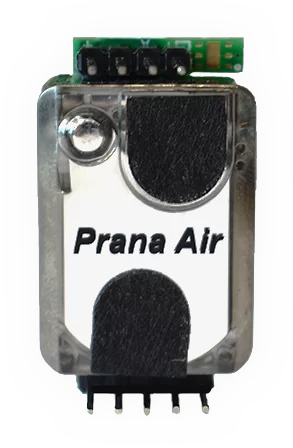
 amazon
amazon